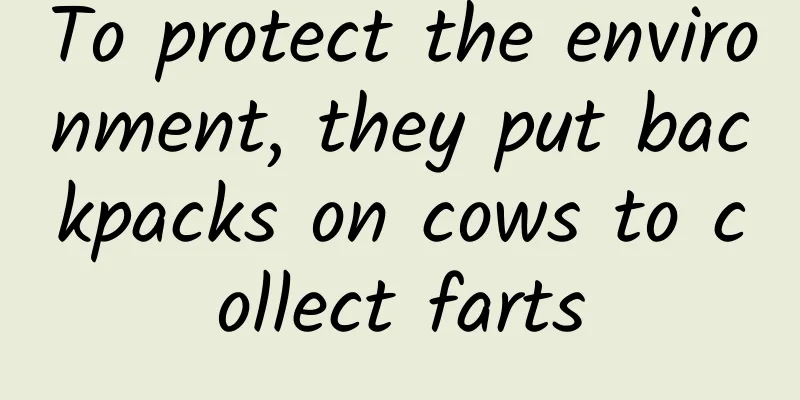To protect the environment, they put backpacks on cows to collect farts

|
Review expert: Zhu Guangsi, member of Beijing Science Writers Association Imagine if a cow farted next to you, the sound would probably be long and lingering, and some "unknown objects" might fly out.
When we ordinary people encounter cow farts, we must avoid them, but has anyone ever thought that there is a group of people who specialize in collecting cow farts? According to media reports, a scientific research team from Argentina can collect about 300 liters of methane gas from a cow every day through experiments. So, what is the purpose of collecting cow farts? Source: Daily Record Agriculture produces about 14% of the world's greenhouse gases . According to statistics, there are 1.5 billion cows and billions of other herbivores in the world, and the methane content of cow farts is as high as 25% , which is an important component of agricultural greenhouse gases. In terms of its impact on global warming, methane is 23 times more powerful than carbon dioxide. The US Food and Agriculture Organization said that by 2030, agricultural methane production may increase by 60%. Source: "Mooooove Over, Cows! Kangaroo Farts Warm the Earth, Too | Live Science" In addition to farting, cows can also emit a lot of methane through burping. Statistics vary on the amount of methane that cows emit on average. Some experts say 100 to 200 liters (about 26 gallons to 53 gallons) per day, while others say up to 500 liters (about 132 gallons) per day. No matter how you count it, this amount of methane is equivalent to the pollution produced by a car in a day . So talking about limiting emissions from cow farts is no joke. But on the other hand, methane can also be used as fuel to power car engines. So using cow farts as car fuel is like killing two birds with one stone. Can cows' burps and farts be used as fuel? Source | sciencejournalforkids.org So how exactly is methane produced in cows, and how is it collected and used? Here is a brief introduction. 1. How methane is released in cattle Ruminants, including cattle, produce methane through their digestive systems and in their feces as a natural result of the food they consume and digest.
This process mainly occurs in the rumen, which is the first stomach of ruminants. The rumen microbial ecosystem in the rumen is closely related to the production of methane. It is like an anaerobic fermentation tank . The cellulose-containing and hemicellulose-containing plants and carbohydrates in the feed ingested by ruminants undergo anaerobically fermentation in the rumen, degrading to produce pyruvic acid and then producing a large amount of carbon dioxide. At the same time, rumen microorganisms release a large amount of electron carriers in the process of degrading carbohydrates to produce volatile fatty acids, and these electron carriers are reduced to hydrogen . Most rumen methanogens (such as the dominant Methanobacterium) can then use hydrogen and formate to reduce carbon dioxide to methane. The hydrogenotrophic pathway is the main methane production pathway in the rumen, with approximately 82% of methane synthesis in the rumen resulting from the reduction of carbon dioxide with hydrogen . Some rumen methanogens can also oxidize methyl structures (such as methylamine, methanol, methyl mercaptan, etc.) into carbon dioxide, generate electrons, and further reduce methyl groups to methane . A few rumen methanogens, such as Methanogens, can react with acetate and convert it into carbon dioxide and methane . Finally, the cow excretes the methane accumulated in the body. The process by which ruminants produce methane | sciencenews.org 2 Argentine agricultural scientists experiment with gas In order to collect cow farts, agricultural scientists in Argentina have designed a balloon-shaped plastic backpack specifically for cows, which can also be called a "cow fart bag." This device can directly insert a tube into the cow's stomach to collect methane produced by the cow at the source, and the tube then passes the collected gas into the backpack. Source: "Collecting Cow Farts: The Stupid-Brilliant Solution To Global Warming") A cow weighing 550 kilograms can release an average of 800-1000 liters of gas every day . According to theoretical calculations, the methane produced by a cow of this weight every day is enough to keep a car running for 72 hours.
Therefore, although collecting cow farts may seem like an unseemly and uncomfortable job, it is actually a scientific research attempt that is both environmentally friendly and energy-saving. These works have created a positive demonstration effect for us humans to reduce greenhouse gas emissions and develop new energy. |
Recommend
Top 10 Marketing Observations in 2020: Integration of Advertising and Private Domain Traffic
A sudden epidemic in 2020 not only affected every...
Southerners vs Northerners, who is fatter? The truth is...
People in the south are thinner than people in th...
No need to ask the "melon photographer" for help, just look here to know whether the watermelon is sweet or not!
Midsummer has quietly arrived. The most pleasant ...
Tik Tok short video operation and promotion methods!
Everyone wants to join Douyin to get a piece of t...
Even Sony's Takeshi Soeda doesn't dare to easily say that it's going smoothly. How can PS VR open up a new path in China?
The news of PS VR landing in China has become a h...
It is said that only people with shortsightedness can understand this picture...
Do you remember what steps are usually taken befo...
The state issued a subsidy for scrapped cars. Deep Blue followed up and increased the subsidy by 10,000 yuan
On April 26, the Ministry of Commerce, the Minist...
5 links to sort out the B-side product operation framework
Currently, many companies that develop B-side pro...
The secret of the temperature of “it’s cold at high altitudes”
Produced by: Science Popularization China Author:...
How does the financial industry play with information flow? Information flow advertising on a P2P platform
As an innovative financial organization model, P2...
To tell a good brand story, you must learn the four golden principles
Why do brands need to tell stories? Stories are a...
Zhongshan e-commerce live broadcast applet development, how can the e-commerce applet have strong competitiveness?
There are many ways for e-commerce to exist, but ...
Chicken eggs, duck eggs, quail eggs, which one is more nutritious? How to choose?
Chicken eggs, duck eggs, quail eggs... There are ...
If you’ve climbed a mountain, how can you not understand machine learning?
In today's booming artificial intelligence, i...
Creating popularity: 6 key points to summarize the communication routines of screen-sweeping
At the beginning of 2018, the entire marketing ci...









